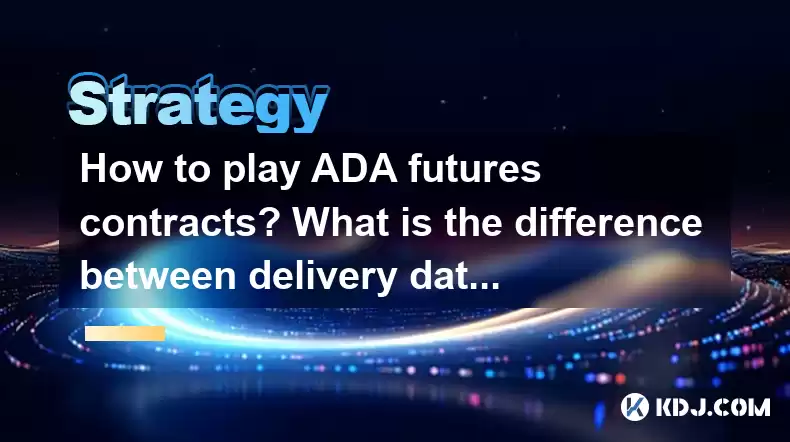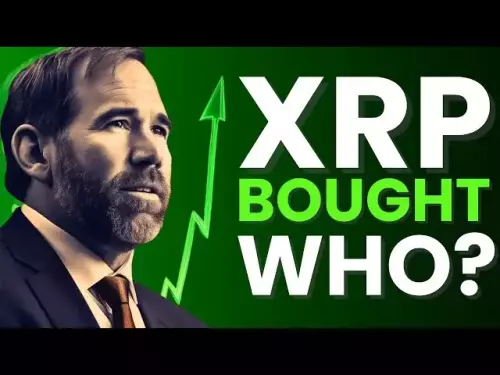-
 bitcoin
bitcoin $108842.957301 USD
-1.88% -
 ethereum
ethereum $3931.777121 USD
-1.66% -
 tether
tether $1.000186 USD
-0.03% -
 bnb
bnb $1153.250882 USD
-2.20% -
 xrp
xrp $2.367904 USD
-1.94% -
 solana
solana $186.182050 USD
-4.20% -
 usd-coin
usd-coin $0.999997 USD
0.00% -
 tron
tron $0.316949 USD
-1.00% -
 dogecoin
dogecoin $0.190780 USD
-3.12% -
 cardano
cardano $0.651324 USD
-2.67% -
 hyperliquid
hyperliquid $37.141055 USD
-0.85% -
 ethena-usde
ethena-usde $0.999224 USD
-0.09% -
 chainlink
chainlink $17.579031 USD
-2.47% -
 bitcoin-cash
bitcoin-cash $509.426284 USD
-2.79% -
 stellar
stellar $0.315298 USD
-2.93%
How to play ADA futures contracts? What is the difference between delivery date and spot?
Trading ADA futures on exchanges like Binance allows speculation on Cardano's price without owning the asset, using leverage to amplify potential gains or losses.
Apr 29, 2025 at 03:07 pm

Trading ADA futures contracts can be an exciting way to engage with the cryptocurrency market, offering potential profits from price movements without the need to own the underlying asset. In this article, we will explore how to play ADA futures contracts, and clarify the differences between delivery date and spot in the context of these financial instruments.
Understanding ADA Futures Contracts
ADA futures contracts are financial derivatives that allow traders to speculate on the future price of Cardano (ADA), one of the leading cryptocurrencies. These contracts obligate the buyer to purchase, and the seller to sell, a specific quantity of ADA at a predetermined price on a specified future date. The primary purpose of futures contracts is to hedge against price volatility or to speculate on price movements.
To start trading ADA futures, you need to have an account with a reputable cryptocurrency exchange that offers futures trading. Some popular exchanges include Binance, Bybit, and FTX. Once you have an account, you can follow these steps to trade ADA futures:
- Log into your exchange account and navigate to the futures trading section.
- Select ADA futures from the list of available contracts. Ensure you understand the contract specifications, such as the contract size, expiration date, and leverage options.
- Choose your trading position: Decide whether you want to go long (buy) if you expect the price of ADA to rise, or go short (sell) if you anticipate a price drop.
- Set your order parameters: Specify the price at which you want to enter the trade, the amount of ADA you wish to trade, and any stop-loss or take-profit levels to manage your risk.
- Execute the trade by clicking the buy or sell button. Monitor your position and adjust your strategy as needed based on market movements.
Key Terminology in ADA Futures Trading
Before diving deeper into ADA futures trading, it's essential to understand some key terms:
- Leverage: This allows traders to control a larger position with a smaller amount of capital. While leverage can amplify profits, it also increases the potential for significant losses.
- Margin: The amount of capital required to open and maintain a futures position. If the market moves against your position, you may receive a margin call, requiring you to deposit additional funds.
- Liquidation: If your account balance falls below the maintenance margin level, your position may be automatically closed to prevent further losses.
Difference Between Delivery Date and Spot
In the context of ADA futures contracts, the delivery date and spot are crucial concepts to understand:
- Delivery Date: This is the date on which the futures contract expires and the underlying asset (ADA) must be delivered. For most cryptocurrency futures, physical delivery is rare, and contracts are typically settled in cash. The delivery date is important because it marks the end of the contract's life, and any open positions must be closed or rolled over to a new contract.
- Spot: The spot price of ADA refers to the current market price at which the cryptocurrency can be bought or sold for immediate delivery. Spot trading involves the direct exchange of ADA for another asset, typically a fiat currency or another cryptocurrency.
The key difference between the delivery date and spot is the timing and nature of the transaction. Spot transactions occur immediately, while futures contracts are agreements for future transactions. The spot price can influence the futures price, but they are not always the same due to factors such as market expectations, interest rates, and the time value of money.
Strategies for Trading ADA Futures
There are several strategies that traders can employ when trading ADA futures:
- Trend Following: This strategy involves identifying and following the prevailing market trend. If ADA is in an uptrend, traders might go long on futures contracts, expecting the price to continue rising. Conversely, in a downtrend, they might go short.
- Arbitrage: This involves exploiting price differences between the futures and spot markets. If the futures price is higher than the spot price, a trader might buy ADA on the spot market and simultaneously sell a futures contract, locking in a profit.
- Hedging: If you hold a significant amount of ADA and are concerned about potential price drops, you can hedge your position by selling ADA futures contracts. This can help offset potential losses in your spot holdings.
Risk Management in ADA Futures Trading
Effective risk management is crucial when trading ADA futures due to the high volatility and leverage involved. Here are some tips to manage your risk:
- Use Stop-Loss Orders: These orders automatically close your position if the price moves against you beyond a certain level, helping to limit potential losses.
- Diversify Your Portfolio: Don't put all your capital into ADA futures. Spread your investments across different assets to reduce risk.
- Monitor Your Positions: Keep a close eye on your open positions and be ready to adjust your strategy based on market conditions.
- Understand Leverage: Be cautious with leverage, as it can amplify both gains and losses. Only use leverage that you can afford to lose.
Practical Example of Trading ADA Futures
Let's walk through a practical example of trading ADA futures:
- Scenario: You believe that the price of ADA will increase over the next month due to an upcoming network upgrade.
- Action: You decide to go long on ADA futures with a leverage of 10x.
- Steps:
- Log into your exchange account and navigate to the ADA futures section.
- Select the ADA futures contract with a one-month expiration date.
- Enter a buy order for the desired amount of ADA at the current market price.
- Set a stop-loss order at 10% below your entry price to limit potential losses.
- Monitor the market and adjust your position as needed.
If the price of ADA rises as expected, you can close your position before the delivery date to realize your profits. If the price drops, your stop-loss order will help limit your losses.
Frequently Asked Questions
Q: Can I trade ADA futures on any cryptocurrency exchange?A: No, not all cryptocurrency exchanges offer futures trading. You need to use an exchange that specifically supports futures contracts, such as Binance, Bybit, or FTX.
Q: What happens if I hold an ADA futures contract until the delivery date?A: Most cryptocurrency futures contracts are settled in cash rather than physical delivery. If you hold a contract until the delivery date, it will be automatically settled based on the final settlement price, and any profits or losses will be credited or debited from your account.
Q: Is trading ADA futures more risky than trading ADA on the spot market?A: Yes, trading ADA futures can be more risky due to the use of leverage, which can amplify both gains and losses. Additionally, futures trading involves more complex strategies and requires a good understanding of market dynamics.
Q: Can I trade ADA futures without owning any ADA?A: Yes, you can trade ADA futures without owning any ADA. Futures contracts are derivative instruments that allow you to speculate on the price movement of ADA without the need to hold the underlying asset.
Disclaimer:info@kdj.com
The information provided is not trading advice. kdj.com does not assume any responsibility for any investments made based on the information provided in this article. Cryptocurrencies are highly volatile and it is highly recommended that you invest with caution after thorough research!
If you believe that the content used on this website infringes your copyright, please contact us immediately (info@kdj.com) and we will delete it promptly.
- Solana, Dogecoin, and the Crypto Dip: Bargain Hunting or Dodging Bullets?
- 2025-10-17 10:45:16
- Gold, Bitcoin, and Investment: Navigating the Digital Frontier in Style
- 2025-10-17 10:25:15
- Bengals vs. Steelers: Live Updates, Week 7 - Who Dey or Black & Gold?
- 2025-10-17 10:25:15
- Dogecoin, Thumzup, and DOGE Rewards: Will Real-World Utility Spark a Rebound?
- 2025-10-17 10:45:16
- BullZilla, Cryptos, Buy October: Navigating the Crypto Jungle in Style
- 2025-10-17 10:50:01
- Cardano, TRON, and MAGACOIN: Navigating the Crypto Landscape in 2025
- 2025-10-17 08:45:15
Related knowledge

Practical parameter settings for a Bitcoin multi-timeframe moving average system
Sep 18,2025 at 10:54pm
Optimizing Timeframe Combinations for Bitcoin Trading1. Selecting appropriate timeframes is crucial when building a multi-timeframe moving average sys...

How can I filter out false breakouts in Dogecoin high-frequency trading?
Sep 22,2025 at 01:00am
Understanding False Breakouts in Dogecoin Trading1. A false breakout occurs when Dogecoin's price appears to move beyond a defined support or resistan...

Techniques for identifying tops and bottoms in the Bitcoin on-chain NVT model
Sep 20,2025 at 07:54pm
Understanding the NVT Model in Bitcoin Analysis1. The Network Value to Transactions (NVT) ratio is often described as the 'P/E ratio' of the cryptocur...

What does the surge in open interest in Bitcoincoin futures mean?
Sep 20,2025 at 11:18pm
Understanding the Surge in Dogecoin Futures Open Interest1. A surge in open interest within Dogecoin futures indicates a growing number of active cont...

How can I use the Ethereum USDT premium to gauge market sentiment?
Sep 18,2025 at 11:55pm
Understanding the Ethereum USDT Premium1. The Ethereum USDT premium refers to the price difference between USDT (Tether) traded on Ethereum-based plat...

What should I do if Ethereum staking yields decline?
Sep 20,2025 at 06:18am
Understanding the Causes Behind Declining Ethereum Staking Yields1. The Ethereum network transitioned to a proof-of-stake consensus mechanism with the...

Practical parameter settings for a Bitcoin multi-timeframe moving average system
Sep 18,2025 at 10:54pm
Optimizing Timeframe Combinations for Bitcoin Trading1. Selecting appropriate timeframes is crucial when building a multi-timeframe moving average sys...

How can I filter out false breakouts in Dogecoin high-frequency trading?
Sep 22,2025 at 01:00am
Understanding False Breakouts in Dogecoin Trading1. A false breakout occurs when Dogecoin's price appears to move beyond a defined support or resistan...

Techniques for identifying tops and bottoms in the Bitcoin on-chain NVT model
Sep 20,2025 at 07:54pm
Understanding the NVT Model in Bitcoin Analysis1. The Network Value to Transactions (NVT) ratio is often described as the 'P/E ratio' of the cryptocur...

What does the surge in open interest in Bitcoincoin futures mean?
Sep 20,2025 at 11:18pm
Understanding the Surge in Dogecoin Futures Open Interest1. A surge in open interest within Dogecoin futures indicates a growing number of active cont...

How can I use the Ethereum USDT premium to gauge market sentiment?
Sep 18,2025 at 11:55pm
Understanding the Ethereum USDT Premium1. The Ethereum USDT premium refers to the price difference between USDT (Tether) traded on Ethereum-based plat...

What should I do if Ethereum staking yields decline?
Sep 20,2025 at 06:18am
Understanding the Causes Behind Declining Ethereum Staking Yields1. The Ethereum network transitioned to a proof-of-stake consensus mechanism with the...
See all articles










































































